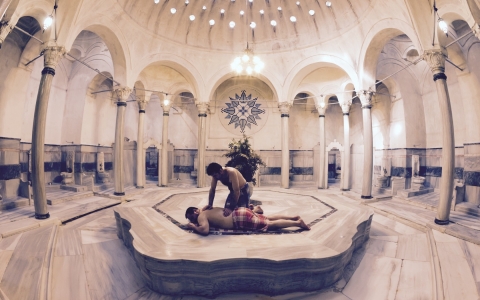The Ultimate Guide to Visit a Turkish Bath or Hammam
A hammam, known as Turkish bath, is the Turkish version of the Roman bath, steam bath, sauna, or Russian banya. They are characterized by a focus on water, as distinct from ambient steam.
Although currently, Turks do most of their showering at home, Turkish baths are still an important part of the culture. Places that are as much about cleansing as they are about relaxing.
Although the first hammams started in Arabia, and bath culture was a central part of Roman life. Turkey spread the tradition by making hammams available to people of all statuses.
In Western Europe, the “Turkish bath” as a method of relaxation and cleansing became popular during the Victorian era. The process entailed in taking a Turkish bath is similar to that of a sauna but is intimately related to ancient Greek and Roman bathing practices.
In traditional hammams female and male sections are separated, yet the bathing rituals are alike between the sexes. The hammam practice is about leaving yourself in the hands of your “natir” or “tellak”, the female or male attendants. They guide visitors through the progressively warmer sections of the bath.
The Turkish bath begins with relaxation in the “warm room,” that is heated by a continuous flow of hot, dry air, letting the bather perspire freely. Bathers may then proceed to an even hotter room, known as “the hot room,” before they wash in cold water. The hot section of a hammam is the most exciting part. Usually, it is designed to let rays of light enter into this area from an elevated central dome, illuminating the steam and generating an otherworldly feeling. Following a full body wash and a massage, bathers finally retire to the cooling-room for relaxation.
The difference between the Victorian Turkish bath and the Islamic hammam is in the air. In the Victorian Turkish bath the air is dry; while in the Islamic hammam, the air is usually steamy. The visitor in a Victorian Turkish bath will immerse themselves in cold water after the hot rooms. The Islamic hammam normally does not have a pool except if the water is running from a spring. In the Islamic baths, the bathers splash themselves with cold water.
Back in the cold section, many hammams will serve bathers a cup of Turkish tea or a glass of sherbet, an Ottoman-style juice. The idea is to spend several minutes allowing your body to come back to its normal temperature.
Before leaving, do not forget to tip your attendants, which is customary in the hamman.
Tags: Bath, hammam, turkish bath


